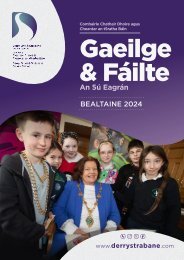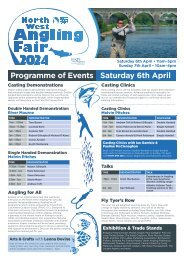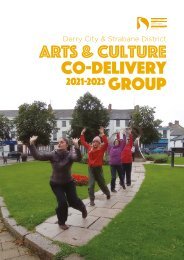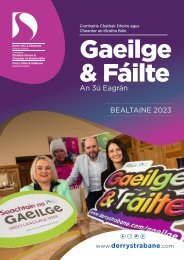DC&SDC_Supplementary Information Document
Create successful ePaper yourself
Turn your PDF publications into a flip-book with our unique Google optimized e-Paper software.
Derry City & Strabane<br />
District Council<br />
Climate Change<br />
Adaptation Plan<br />
2020-2025<br />
<strong>Supplementary</strong><br />
<strong>Information</strong> <strong>Document</strong>
2 Climate Change Adaptation Plan
Contents<br />
Introduction 4<br />
Regional Profile 6<br />
Landscape 7<br />
Socio – Economic Profile 8<br />
Culture 8<br />
Infrastructure 9<br />
The Climate Challenge 10<br />
Observations & Projections 13<br />
Climate Change Risk 18<br />
Heat Impacts and Built Environment 24<br />
Natural Environment 25<br />
International 26<br />
Strategic Context 27<br />
Case for Local Government Climate Adaptation 38<br />
Bibliography 41<br />
<strong>Supplementary</strong> <strong>Information</strong> <strong>Document</strong><br />
3
Introduction<br />
This document provides additional information supporting the Derry City and Strabane District Council Climate Change<br />
Adaptation Plan. Detailed background information and analysis provides further context to the regional profile, the challenge of<br />
climate change and associated risks and the rationale for climate adaptation within Council.<br />
The Climate Adaptation Plan provides a framework for cohesive adaptation action within Derry City and Strabane District Council.<br />
Our Aims<br />
Our Vision<br />
“Derry City & Strabane District<br />
Council is prepared for and<br />
resilient to the effects of climate<br />
change creating a safe and<br />
sustainable region for all”<br />
• Increase capacity to respond to climate<br />
change ensuring resilience of our services,<br />
people, operations, assets and estate to the<br />
impacts of climate change.<br />
• Raise awareness of the impacts of climate<br />
change across the City & District to deliver<br />
effective adaptation.<br />
• Lead by ex<strong>amp</strong>le and work collaboratively<br />
to ensure resilience and deliver climate<br />
adaptation.<br />
4 Climate Change Adaptation Plan
Themes<br />
The associated Climate Adaptation Action Plan outlines the short,<br />
medium and long-term actions to be delivered within the initial<br />
5-year period by Council. Actions are allocated to each theme<br />
and categorised as those that are enabling by building adaptive<br />
capacity and those that deliver planning & adaptation action.<br />
Cross Cutting<br />
Delivery &<br />
Collaboration<br />
Functional Themes<br />
Policy &<br />
People<br />
Communication<br />
& Awareness<br />
Assets & Capital<br />
Development<br />
Knowledge &<br />
<strong>Information</strong><br />
Operations &<br />
Services<br />
Green<br />
Infrastructure<br />
Heritage &<br />
Culture<br />
Planning<br />
& Building<br />
Control<br />
<strong>Supplementary</strong> <strong>Information</strong> <strong>Document</strong><br />
5
Regional Profile<br />
The landscape of the Council area includes mountain ranges, rivers, agricultural land, and coast offering vital habitats for species,<br />
destinations for tourism and recreation, a rich cultural heritage as well as settlements for local communities. Urban areas include<br />
the regional city of Derry connected to a number of vibrant towns including Strabane and a wide number of villages.<br />
Area: 1,245 km²<br />
Population: 150,680 of which<br />
71% live in urban areas<br />
Settlements: 47<br />
Border with Donegal County<br />
Council, Republic of Ireland:<br />
140km<br />
Neighbouring Councils:<br />
Causeway Coast & Glens<br />
Borough Council / Mid-<br />
Ulster and Fermanagh &<br />
Omagh District Council<br />
Derry City & Strabane District Council Area<br />
6 Climate Change Adaptation Plan
Landscape<br />
The City & District contains many areas of significant environmental and landscape importance including the Sperrin Area of<br />
Outstanding Natural Beauty, Lough Foyle Special Protection Area, River Faughan and River Foyle Special Areas of Conservation<br />
and the special wetlands and wildlife found on the Ramsar sites of Lough Foyle and Fairy Water Bogs.<br />
Significant rivers include the Rivers Foyle, Faughan, Skeoge, Mourne, Derg and Glenelly River as well as numerous tributaries and<br />
wider catchment areas.<br />
Ireland’s geographical situation explains our changeable weather. The dominant influence on Ireland’s climate is the Atlantic<br />
Ocean which produces mild/wet weather and a moderate climate. Winters tend to be cool and windy, summers mild and less<br />
windy.<br />
<strong>Supplementary</strong> <strong>Information</strong> <strong>Document</strong><br />
7
Socio-economic Profile<br />
The area serves a population of 150,680 with the overall population projected to decrease slightly to 150,496 in 2022 before<br />
dropping back to 145,852 by 2041.<br />
In 2019, there were 62,462<br />
domestic properties served<br />
by Derry City and Strabane<br />
District Council.<br />
In 2019, there were 5,260 VAT<br />
and/or PAYE registered businesses<br />
within the area, which, in turn, had<br />
helped provide 58,200 employee<br />
jobs in 2018.<br />
In 2018, there were 1,771<br />
farms within DC<strong>SDC</strong><br />
supported by an agricultural<br />
labour force of 3,510.<br />
The Northern Ireland Multiple Deprivation Measure 2017 results show that 20 of the 100 most deprived Super Output Areas<br />
(SOAs) in Northern Ireland are located in the Council area.<br />
Deprivation is particularly prevalent in some parts of Derry City, parts of Strabane Town and certain parts of its surrounding<br />
countryside. In addition, the 2011 census recorded 33% of those economically inactive as a result of disability or long term illness.<br />
Culture<br />
The Council area also has a rich and diverse built and archaeological heritage including remains of remote ancient settlements<br />
and castles, ritual sites and tombs, and many buildings of architectural importance. The area contains 5 Conservation Areas, 4<br />
Areas of Townscape Character, 675 listed buildings, 857 sites on the current NI Sites and Monuments Record, 18 Monuments in<br />
State Care and 10 Scheduled Monuments in State Care.<br />
Notable sites include the iconic Derry Walls - the largest monument in State Care in Northern Ireland, 14th Century Harry Avery’s<br />
Castle (Newtownstewart) and the 15th Century Derg Castle (Castlederg).<br />
The Walled City is a special cultural and historic city quarter with museums, arts venues, retail and hospitality. The City and District<br />
have become internationally renowned for its world-class festivals and events including the annual Halloween Festival, Spring<br />
Carnival and Maritime Festival.<br />
8 Climate Change Adaptation Plan
Infrastructure<br />
The City and District’s infrastructure includes Foyle port and<br />
harbour, city airport, rail links, multi-modal transport hub, roads<br />
and greenways.<br />
Northern Ireland’s second largest acute hospital is located in<br />
the city. Altnagelvin includes the only cross-border Cancer<br />
Centre on the island of Ireland.<br />
The City and District contains over 90km of cycleways,<br />
greenways and 1,000 acres of parkland.<br />
Ulster University, Magee C<strong>amp</strong>us is located in the city as well<br />
as two c<strong>amp</strong>uses of North West Regional College in Derry and<br />
Strabane.<br />
Future road infrastructure plans include the proposed dualling<br />
of the A5 carriageway, a new dual carriageway as part of the<br />
proposed A6 dualling between Derry and Dungiven, and the<br />
upgrade of the A2 at Buncrana Road in Derry.<br />
Energy supply within the City & District is based on a mix of<br />
Coolkeeragh Combined / Open Cycle Gas Turbine Power Plant<br />
and wind energy with Northern Ireland Electricity Network<br />
responsible for network operation and distribution. Renewable<br />
energy infrastructure includes numerous wind farms and bioenergy<br />
production sites.<br />
<strong>Supplementary</strong> <strong>Information</strong> <strong>Document</strong><br />
9
The Climate Challenge<br />
The Earth is kept warm by what is known as the greenhouse effect, where certain gases in the atmosphere trap heat, preventing it<br />
escaping into space. These greenhouse gases (GHG) include water vapour, methane, nitrous oxide and carbon dioxide.<br />
The build-up of greenhouse gases in the atmosphere from human activity is trapping the sun’s<br />
heat, resulting in warming of the planet and changes in weather patterns around the world.<br />
Climate change refers to slow onset, long term shifts in average temperatures and weather patterns typically over a 30-<br />
year period.<br />
Weather refers to the conditions we experience over shorter periods of time from hours to days.<br />
10 Climate Change Adaptation Plan
The climate of the Earth is not static, and has changed many times in the past. Natural processes such as variations in the earth’s orbit, cyclical ocean patterns, volcanic<br />
eruptions and changes in the amount of solar energy the planet receives can also contribute to climate change.<br />
Human activities, (anthropogenic) including the burning fossil fuels, changing land use, agriculture, decomposition of waste and deforestation have resulted in the release of<br />
large amounts of greenhouse gases into the atmosphere, enhancing the warming effect and so increasing global temperatures.<br />
The build-up of greenhouse gases in the atmosphere since the start of the industrial revolution has resulted in GHG levels 30% higher than at any time during the last 800,000<br />
years. (Climate Ireland, 2020)<br />
Global anthropogenic C02 emissions<br />
Quantitative information of CH4 and N20 emission time series from 1850 to 1970 is limited<br />
Cumulative C02<br />
emissions<br />
40<br />
(GtC02/yr)<br />
35<br />
30<br />
25<br />
20<br />
15<br />
Fossil fuels, cement and flaring<br />
Forestry and other land uses<br />
(GtC02)<br />
2000<br />
1500<br />
1000<br />
10<br />
500<br />
5<br />
0<br />
0<br />
1850 1900 1950 2000 1750<br />
Year<br />
1970<br />
(IPCC, 2014)<br />
1750<br />
2011<br />
<strong>Supplementary</strong> <strong>Information</strong> <strong>Document</strong><br />
11
Global mean temperature difference from 1850 - 1900 ( o C)<br />
o C<br />
1.4<br />
1.2<br />
1.0<br />
0.8<br />
0.6<br />
0.4<br />
0.2<br />
HadCRUT<br />
NOAAGlobalTemp<br />
GISTEMP<br />
Cowtan and Way<br />
Berkeley Earth<br />
ERA - 5<br />
JRA - 55<br />
Global Data Sets<br />
Since the late 19th<br />
century, average<br />
global temperatures<br />
have increased by<br />
approximately 1°C, with<br />
global warming likely<br />
to reach 1.5°C between<br />
2030 and 2052.<br />
0.0<br />
-0.2<br />
1850 1875 1900 1925 1950 1975 2000 2025<br />
Year<br />
(Met Office, 2020)<br />
According to the World Meteorological Organisation, 2019 was<br />
the second warmest year on record after 2016 with average<br />
temperatures for 2010-2019 being the highest on record.<br />
The Paris Agreement of 2015 saw a global commitment to keep<br />
global temperature rise this century 2°C below pre industrial<br />
levels and pursue efforts to keep the rise to no more than 1.5°C.<br />
However, global warming is likely to reach 1.5°C from as early as<br />
2030 and reach 4°C by 2100 (Met Office, 2020).<br />
Climate-related risks to health, livelihoods, food security, water<br />
supply, human security, and economic growth are projected<br />
to increase with global warming of 1.5°C and increase further<br />
with 2°C. Even if vigorous efforts to limit the emissions of<br />
greenhouse gases from human activities are undertaken, the<br />
world is locked into further climatic changes.<br />
12 Climate Change Adaptation Plan
Limiting global warming to 1.5°C would require “rapid and<br />
far-reaching” transitions in land, energy, industry, buildings,<br />
transport, and cities and requires a cut in greenhouse gas<br />
emissions of 45% by 2030 compared to 2010, and zero by<br />
2050. (IPCC, 2018)<br />
GHG emissions have continued to rise at a rate of 1.5 per<br />
cent per year from 2010-2019, reaching a record high of 55.3<br />
GtCO2e in 2018.<br />
Carbon dioxide lasts in the atmosphere for centuries and the<br />
ocean for even longer, thus locking in climate change.<br />
While Northern Ireland is likely to avoid some of the most<br />
severe direct impacts manifesting in some other regions, there<br />
will be impacts, both direct and indirect.<br />
Observations & Projections<br />
Observed Changes<br />
Northern Ireland’s climate is changing in line with global patterns with average temperatures rising across all seasons. Northern<br />
Ireland is also seeing a rise in sea levels as well as a change in the frequency and intensity of extreme weather events.<br />
Projections<br />
The UK Met Office 2018<br />
Climate Change Projections<br />
state that for the UK there is;<br />
“A greater chance of<br />
warmer, wetter winters<br />
and hotter, drier summers”<br />
(Met Office, UK 2019)<br />
<strong>Supplementary</strong> <strong>Information</strong> <strong>Document</strong><br />
13
Climate projections present a range of low to high future scenarios based on the degree to which society reduces greenhouse<br />
gas emissions and therefore projected global temperatures.<br />
For the purpose of the Climate Change Adaptation Plan scenarios RCP2.6 (Low Emission) and RCP8.5 (High Emission) which<br />
relate most closely to 2°C and 4°C global warming by the end of the century respectively, relative to preindustrial era have been<br />
used. We used these two RCPs in order to represent both a most optimistic and most pessimistic level of action (other RCP<br />
scenarios represent “middle ground” between RCP2.6 and RCP8.5 in terms of the level of action on climate change and therefore<br />
associated impact).<br />
Name Radiative Forcing CO2 Levels<br />
RCP8.5 8.5 Wm² in 2100 High Levels<br />
Rising<br />
(~1370 ppm CO2 eq) by 2100<br />
RCP6.0 6 Wm² post 2100 Medium<br />
Low Mitigation<br />
(~850 ppm CO2 eq) at<br />
stabilization after 2100<br />
RCP4.5<br />
RCP2.6<br />
4.5 Wm² post<br />
2100<br />
3 Wm² before<br />
2100 declining to<br />
2.6 Wm² by 2100<br />
Medium<br />
High Mitigation<br />
(~650 ppm CO2 eq) at<br />
stabilization after 2100<br />
Very Low Levels<br />
Peak & Decline<br />
(~490 ppm CO2 eq) before<br />
2100 and then decline<br />
14 Climate Change Adaptation Plan
Parameter Observed Projected Ex<strong>amp</strong>le of Impacts<br />
Temperature<br />
For the period 2009-2018 average<br />
temperature was 0.9°C warmer<br />
than the 1961-1990 average<br />
All the top 10 warmest years for<br />
the UK from 1884 have occurred<br />
since 2002<br />
Summer 2018 was among the<br />
warmest, driest and sunniest<br />
summers experienced by the UK<br />
for over 100 years<br />
(Kendon et al., 2019)<br />
By 2070 (Compared to 1981-2000)<br />
Low Emission Scenario up to 2.8°C<br />
hotter<br />
High Emission Scenario up to<br />
4.9°C hotter<br />
The chance of a summer heatwave<br />
like 2018 is around 50% more likely<br />
by 2050<br />
(Met Office, 2019)<br />
Cold snaps like -18.7 °C at<br />
Castlederg in 2010 will still<br />
occur but are projected to be<br />
less frequent as winters become<br />
warmer on average<br />
Increased heat-related mortality<br />
and illness<br />
Reduced air quality<br />
Transport and energy infrastructure<br />
affected<br />
Increased visitor numbers to parks<br />
and open spaces<br />
Increased risk of pest and disease<br />
and spread of invasive species<br />
Health and wellbeing benefits<br />
of warmer winters as well as<br />
reduction in fuel / heating costs<br />
Winter<br />
Precipitation<br />
Winters were on average 12%<br />
wetter during the period 2009-<br />
2018 when compared with 1961-<br />
1990<br />
(Kendon et al., 2019)<br />
By 2070 (Compared to 1981-2000)<br />
Low Emission Scenario up to 17%<br />
increase<br />
High Emission Scenario up to 25%<br />
increase<br />
(Met Office, 2019)<br />
Property damage – residents,<br />
business & Council estate<br />
Damage to infrastructure – roads<br />
rail, power, & green infrastructure<br />
Business trading loss<br />
Risk to public safety, mental health<br />
and wellbeing<br />
Increased pollution and reduced<br />
water quality<br />
<strong>Supplementary</strong> <strong>Information</strong> <strong>Document</strong><br />
15
Parameter Observed Projected Ex<strong>amp</strong>le of Impacts<br />
Summer<br />
Precipitation<br />
During 2009-2018 summers were<br />
on average 13% wetter than the<br />
1961 -1990 average<br />
(Kendon et al., 2019)<br />
Northern Ireland Water experienced<br />
a ‘High Demand Incident’ leading<br />
to the first hosepipe ban in two<br />
decades during the heatwave of<br />
summer 2018<br />
By 2070 (Compared to 1981-2000)<br />
Low Emission Scenario up to 28%<br />
decrease<br />
High Emission Scenario up to 38%<br />
decrease<br />
However future increases in the<br />
intensity of heavy summer rainfall<br />
events are projected<br />
(Met Office, 2019)<br />
Reduced river flows affecting<br />
biodiversity and water quality<br />
Reduced water supply<br />
Increased risk of wildfire<br />
Rising Sea<br />
Levels<br />
Mean sea level around the UK has<br />
risen by about 16 cm since the<br />
start of the 20th century (when<br />
corrected for land movement)<br />
(Kendon et al., 2019)<br />
Northern Ireland is locked in to<br />
at least 11cm sea-level rise by<br />
2100, but unless global emissions<br />
decline, that number could be as<br />
much as 94cm<br />
(Met Office, 2019)<br />
Increased risk of coastal storm<br />
surge and storm tide inundation<br />
Significant impact on flood<br />
defences, coastal habitat, urban<br />
centres, agricultural land and<br />
infrastructure<br />
Frost & Snow<br />
2009–2018 has had 15% fewer air<br />
and ground frost days compared to<br />
1961–1990<br />
(Kendon et al., 2019)<br />
Widespread and substantial snow<br />
events have occurred in 2018, 2013,<br />
2010 and 2009, but their number<br />
and severity have generally declined<br />
since the 1960s<br />
(Kendon et al., 2019<br />
A decrease in the frequency of<br />
frost and snow is projected<br />
Decrease in transport disruption<br />
Property damage & transport<br />
disruption may occur with<br />
instances of severe frost and snow<br />
however projections indicate<br />
increase in average temperatures.<br />
Potential benefits to health and<br />
wellbeing and reduced costs for<br />
heating and treatment of roads &<br />
paths<br />
16 Climate Change Adaptation Plan
Parameter Observed Projected Ex<strong>amp</strong>le of Impacts<br />
Growing<br />
Season<br />
Northern Ireland’s Growing Degree<br />
Days (Conditions suitable for<br />
plant growth) 2008-2018 saw an<br />
increase of 11.8% days compared to<br />
the 1961-1990 period<br />
(Kendon et al., 2019)<br />
An increase in the duration of the<br />
growing season is likely with spring<br />
occurring earlier<br />
Impact on biodiversity as well as<br />
Council grounds maintenance<br />
regimes<br />
Relative<br />
Humidity<br />
RH is likely to increase especially<br />
during winter months<br />
(Nolan, 2019)<br />
Increased mould growth on<br />
buildings and museum collections<br />
(Observed changes data: years 2009–2018 is a non-standard reference period, but it provides a 10-year “snapshot” of the most recent experience of the UK’s climate<br />
compared to historical records.)<br />
“Changing climate leads to changes in the frequency,<br />
intensity, spatial extent, duration, and timing of extreme<br />
weather and climate events.”<br />
(IPCC, 2012)<br />
“Climate change will <strong>amp</strong>lify existing risks and create<br />
new risks for natural and human systems in Europe,<br />
in particular through increased damages from river<br />
and coastal floods, increased water restrictions, and<br />
increased damages from heat events and wildfires”.<br />
(IPCC, 2014)<br />
<strong>Supplementary</strong> <strong>Information</strong> <strong>Document</strong><br />
17
Climate Change Risk<br />
The UK Climate Change Risk Assessment 2017 Evidence Report – Summary for Northern Ireland highlights the following areas of<br />
risk & opportunity:<br />
• Natural Environment<br />
• Infrastructure<br />
• People & Built Environment<br />
• Business & Industry<br />
• International<br />
Following the key themes of the UK Climate Change Risk Assessment the main risks for Northern Ireland are outlined below:<br />
People and Built<br />
Environment<br />
As figure 1 illustrates climate stability is a key determinant of health and wellbeing.<br />
Climate change has the potential to impact the built environment,<br />
infrastructure, economy and the places we live.<br />
The extent to which individuals are able to cope with the impacts of climate<br />
change is influenced by the interaction between personal factors (e.g. health,<br />
age), social factors (e.g. income, neighbourhood cohesion, isolation), and<br />
environmental factors (e.g. building quality, green space).<br />
The groups most at risk from climate change are the very old and very young,<br />
those with chronic diseases, impaired mobility and on certain medications,<br />
pregnant women, homeless, those with limited finance capacity, and people<br />
engaged in outdoor activities.<br />
Figure 1<br />
(Barton and Grant, 2006)<br />
18 Climate Change Adaptation Plan
Heat Impacts & People<br />
According to the 2017 UK Climate Change Risk Assessment,<br />
there are 2,000 heat-related deaths per year in the UK and 17 in<br />
Northern Ireland.<br />
The specific risks for human health includes:<br />
• Increased incidence of heat-related illnesses including<br />
heat stroke, heat exhaustion, cr<strong>amp</strong>s and an increased risk<br />
of heat-related deaths.<br />
• An increased health risk from water, vector and food<br />
borne diseases.<br />
• An increased risk in the number of skin cancer cases and<br />
deaths.<br />
• Potential for longer pollen and allergy season while<br />
thunderstorms have also been associated with increased<br />
hospital admittances for asthma.<br />
• A warming climate also threatens to make air quality<br />
worse, with the prevalence of harmful smogs likely to<br />
increase throughout longer, hotter summers.<br />
• Wildfires cause risk of injury and death.<br />
People in areas of high social deprivation are most at risk from<br />
increasingly frequent warm spells due to less resources to<br />
purchase additional cooling solutions.<br />
In addition, the NI Evidence Report 2017 highlighted potential<br />
opportunities and benefits of higher temperatures on health<br />
and wellbeing such as increased outdoor activities, and health<br />
benefits from warmer winters, reduced cold and fuel poverty.<br />
Flooding / Storms Impacts & People<br />
The impact on local people, health and wellbeing from severe<br />
weather events such as flooding and storms includes:<br />
• Injury and death.<br />
• Public health and safety risks for residents e.g. pollution,<br />
pests and disease.<br />
• Long-term physical and mental health impacts.<br />
• Damage to homes.<br />
• Financial impacts - loss of assets and insurance costs.<br />
“It’s caused me many sleepless nights because you’re<br />
constantly thinking about flooding, and you think you’re<br />
getting somewhere with it and then you hit a brick wall.<br />
Every single day now before we arrange to do anything<br />
or go out anywhere, we have to check the Met Office<br />
weather report on the internet”<br />
Accounts from residents affected by flooding.<br />
(British Red Cross, 2010)<br />
Power cuts, transport disruption and flooding associated with<br />
frequent severe weather events will affect the most vulnerable<br />
members of the community, who may have fewer resources<br />
and support to clean up after a flood or to reduce future risk<br />
e.g. increasing insurance premiums.<br />
<strong>Supplementary</strong> <strong>Information</strong> <strong>Document</strong><br />
19
North West Flood Risk<br />
Recent research undertaken by the Newcastle University found<br />
that Derry City could experience an 80% increase in the current<br />
one in ten-year flood events.<br />
“Derry City - is potentially more at risk from climate change<br />
than other parts of the UK” Dr Selma Guerreiro.<br />
“The research highlights the urgent need to design and adapt<br />
our cities to cope with these future conditions.”<br />
Professor Richard Dawson. (Guerreiro et al., 2018)<br />
Derry City has also been identified by the Department for<br />
Infrastructure as an Area of Potential Significant Flood Risk<br />
where significant flood risk exists now or is likely to occur in the<br />
future while Strabane is listed as a Transitional Area of Potential<br />
Significant Flood Risk. (DFI, 2018)<br />
As an Area of Potential Significant Flood Risk, the City of Derry<br />
was subject to detailed flood risk analysis, which highlighted<br />
that the predominant flood risk arises from fluvial (River)<br />
flooding.<br />
The low lying areas behind the quays on the west side of<br />
the Foyle – for ex<strong>amp</strong>le, Foyle Street, Water Street, Foyle<br />
Embankment, Queens Quay, Strand Road and Rossville Street.<br />
(DARD, 2015)<br />
In addition, DFI coastal modelling predicts that at the 10%<br />
annual exceedance probability tidal event (1 in 10 years)<br />
flooding would take place due to overtopping of the quay at<br />
the Foyle Embankment and the banks at or near the Pennyburn<br />
Stream outlet to the Foyle. At the 2% (1 in 50 years) annual<br />
exceedance probability event overtopping of banks/quays<br />
would also take place near the Craigavon Bridge, at Queen’s<br />
Quay and the McFarland Quay.<br />
20 Climate Change Adaptation Plan
Coastal flooding is often characterised by flows that are<br />
more rapid and dynamic than for other sources of flooding<br />
and therefore the consequential risk to public safety and<br />
property is relatively high. Also, the long term economic and<br />
environmental damage is generally higher due the effects of<br />
saltwater inundation.<br />
The Department for Infrastructure’s NI Climate Change Flood<br />
Maps highlight the estimated tidal, river and surface water<br />
flooding for the year 2030 representing medium probability,<br />
this allows for an indication of flood risk for 2030 while the<br />
UKCP18 projections enable a longer term analysis of risk up for<br />
2070.<br />
At the time of writing this adaptation plan the NI Flood<br />
Maps were undergoing revision to include the CP18 data,<br />
the updated maps will be used when undertaking future<br />
assessments to inform adaptation measures in the City &<br />
District.<br />
In deciding on Planning applications, the Council will continue<br />
to apply existing regional Planning policies so as to ensure<br />
that all public and private developers across the District are<br />
undertaking sustainable forms of development e.g. by ensuring<br />
that new buildings or land uses are not located in flood plains<br />
where they would flood or cause flooding elsewhere.<br />
Infrastructure / Business & Industry<br />
Local infrastructure is critical to the successful operation of<br />
society and business where several interdependencies often<br />
impact upon others (cascade failure) e.g. disrupted electricity<br />
supply impacts business operations, water management and<br />
health service provision.<br />
<strong>Supplementary</strong> <strong>Information</strong> <strong>Document</strong><br />
21
Heat Impacts & Infrastructure<br />
Impacts from increased temperatures include:<br />
• Rail network disruption / speed restrictions to reduce the<br />
risk of track buckles.<br />
• Pressure on local energy supply due to increased energy<br />
demand for cooling systems.<br />
• Water shortages affecting business and domestic supplies.<br />
• Reduced workforce productivity.<br />
Flooding and Storms Impacts &<br />
Infrastructure<br />
Infrastructure is at significant risk from severe weather events<br />
e.g. storms and flooding leading to:<br />
• Closure and damage of roads, rail and bridges.<br />
• Landslides.<br />
• Coastal erosion.<br />
• Speed restriction on roads and bridges for high sided<br />
vehicles.<br />
• Reduced customer access.<br />
• Distribution to networks, ICT, electivity supply, supply<br />
chains and service deliveries.<br />
• Lost workdays.<br />
• Increasing insurance and repair costs.<br />
22 Climate Change Adaptation Plan
Flooding and Storms Impacts &<br />
Business & Industry<br />
Small and Medium Enterprises (SMEs) can be particularly<br />
vulnerable to climate change and extreme weather impacts<br />
can be highly damaging. SMEs are likely to have a have a lower<br />
adaptive capacity and may have the most difficulty recovering<br />
due to not being ‘as well-resourced’ as much larger enterprises<br />
(DAERA, 2019).<br />
The transition to a well-adapted region presents a number<br />
of opportunities for the business sector to both manage<br />
their own risk but also provide the services and infrastructure<br />
required for the North West to adapt and thrive to changes in<br />
the climate. Key to this will be understanding and exploiting<br />
the opportunities from the existing expertise in local science,<br />
research and product development, manufacturing and<br />
engineering.<br />
Opportunities also include a possible extension of the tourist<br />
season. However this may result in increased pressure on<br />
heritage sites and outdoor spaces such as parks and outdoor<br />
play areas. Water shortages and severe weather events have<br />
potential to cause deterioration and damage to the natural<br />
environment affecting the aesthetics and visitor offer.<br />
<strong>Supplementary</strong> <strong>Information</strong> <strong>Document</strong><br />
23
Heat Impacts & Built Environment<br />
The built environment is also affected by climate change. Increased temperatures and heatwaves result in;<br />
• Subsidence and heat-related damage or disruption to buildings.<br />
• Increased energy consumption from cooling and refrigeration.<br />
• Increased temperatures and fluctuations puts pressure on heritage assets through thermal stress affecting building fabric,<br />
stonework, archaeological remains and collections.<br />
• Increased relative humidity affects museum collections.<br />
24 Climate Change Adaptation Plan
Natural Environment<br />
Increasing global temperatures are already affecting our natural<br />
environment and based on current trends this human impact<br />
will escalate for decades to come.<br />
Many terrestrial, freshwater and marine species have shifted<br />
their geographic ranges, seasonal activities, migration patterns,<br />
abundances and species interactions in response to ongoing<br />
climate change (IPCC, 2014).<br />
Changes to the natural environment can be<br />
caused and exacerbated by climate change.<br />
Climate change has potential to lead to a net<br />
loss in natural capital and negatively impact our<br />
ecosystem services resulting in species loss and<br />
habitat degradation.<br />
(Department for Agriculture, Environment and<br />
Rural Affairs, 2019)<br />
However, many species will not be able to adapt fast enough<br />
to respond to the current pace of climate change, in addition<br />
suitable habitat and networks for colonisation may not exist.<br />
The scale of local extinctions will depend on the availability of<br />
suitable habitat and conditions for species to move. In addition<br />
changing conditions and temperatures may also be more<br />
favourable for invasive species.<br />
As well as increased temperatures, extreme weather events<br />
affect local ecosystems and habitats through:<br />
• Reduced precipitation events leading to low flow<br />
conditions reducing dilution of pollutants.<br />
• High flows during flooding causes runoff of sediment and<br />
pollution.<br />
• Wildfires pose a risk to habitats and species.<br />
Flooding can also cause:<br />
• Soil erosion.<br />
• Landslides.<br />
• Coastal erosion.<br />
Climate change may create better conditions for some flora<br />
and fauna, increase productivity on forests and woodland<br />
and agricultural production and crop diversity. In addition,<br />
the development of Green Infrastructure (GI) as a response to<br />
climate change offers opportunities for habitat enhancement,<br />
connectivity and protection for our natural environment.<br />
The Biodiversity Theme of the Derry & Strabane Green<br />
Infrastructure Plan 2019 - 2032, represents Council’s Local<br />
Biodiversity Action Plan and aims to ‘support wildlife and<br />
habitats that provide ecosystem services’ (Derry City & Strabane<br />
District Council, 2019a).<br />
<strong>Supplementary</strong> <strong>Information</strong> <strong>Document</strong><br />
25
International<br />
Local businesses are exposed to the<br />
indirect impacts of climate change due<br />
to their dependence upon the wider<br />
Irish, European and global economy,<br />
supply chains and markets.<br />
There are likely to be opportunities and<br />
risks from climate change on our food<br />
system including production and trade<br />
including:<br />
• Impacts on agricultural production.<br />
• Changes in growing season.<br />
• Damage to land and crops.<br />
• Risk to fodder production.<br />
• Increases in pests and diseases.<br />
• Risk to supply chains and food<br />
imports.<br />
• Opportunities for agricultural diversification e.g. different crops, plant species, production of renewable energy.<br />
The Journal of Spatial Planning in Ireland (Murphy, 2016) highlights that adapting to climate change is most challenging in close<br />
proximity to boundaries. The report states that on the island of Ireland border regions are amongst the most vulnerable to the<br />
hydro –climatic hazards mainly due to a lack of joined up thinking and action around shared environmental issues and climate<br />
adaptation. Political issues such as BREXIT adds considerable uncertainty to the economic outlook and has the potential to<br />
significantly change the dynamic of cross border trade and partnership working.<br />
26 Climate Change Adaptation Plan
Strategic Context<br />
Council’s Adaptation Plan is influenced by and contributes to a number of international, national and local policies and plans.<br />
The following table outlines the current relevant strategic context and headline statements pertaining to climate change;<br />
Area<br />
Strategy/ Policy<br />
/ Legislation/<br />
<strong>Document</strong> Title<br />
Organization/<br />
Department/<br />
Agency<br />
Relevant Statement(s)<br />
International &<br />
EU<br />
Paris Agreement<br />
2015<br />
United Nations<br />
(United Nations<br />
Framework on<br />
Climate Change)<br />
195 Global<br />
Signatories<br />
> Requires ambitious mitigation action to reduce GHG emissions<br />
to hold the global temperature rise ‘well below 2°C above preindustrial<br />
levels’, and to pursue efforts to limit the rise to 1.5°C.<br />
> Adaptation goal; ‘enhancing adaptive capacity, strengthening<br />
resilience and reducing vulnerability to climate change’.<br />
European Union<br />
Climate Change<br />
Adaptation<br />
Strategy 2013<br />
European Union<br />
> Promoting action by EU Member States: the EU Commission<br />
encourages all Member States to adopt comprehensive<br />
adaptation strategies and provides funding to help build up<br />
adaptation capacities and take action.<br />
> Climate-proofing by further promoting climate change<br />
adaptation in key vulnerable sectors.<br />
> Better informed decision-making by addressing gaps in<br />
knowledge about adaptation and further developing the<br />
European climate adaptation platform (Climate-ADAPT) as the<br />
‘one-stop shop’ for adaptation information in Europe.<br />
<strong>Supplementary</strong> <strong>Information</strong> <strong>Document</strong><br />
27
Area<br />
International &<br />
EU<br />
UK<br />
Strategy/ Policy<br />
/ Legislation/<br />
<strong>Document</strong> Title<br />
United<br />
Nations 2030<br />
Sustainable<br />
Development<br />
Goals (SDG 13)<br />
Climate Change<br />
Act 2008<br />
Organization/<br />
Department/<br />
Agency<br />
United Nations<br />
Relevant Statement(s)<br />
> Strengthen resilience and adaptive capacity to climate-related<br />
hazards and natural disasters in all countries;<br />
> Integrate climate change measures into national policies,<br />
strategies and planning;<br />
> Improve education, awareness-raising and human and<br />
institutional capacity on climate change mitigation, adaptation,<br />
impact reduction and early warning;<br />
> Mobilise and distribute 50% of the UN Framework Convention<br />
on Climate Change Green Climate Fund to adaptation projects in<br />
developing countries; and<br />
> Promote mechanisms for raising capacity for effective climate<br />
change-related planning and management in least developed<br />
countries and small-island developing States, including focusing<br />
on women, youth and local and marginalised communities.<br />
UK Parliament > Set UK GHG target (Net zero by 2050)<br />
> Sets legally binding carbon budgets (cap over 5 yr period – set<br />
12 yrs in advance) 1 First 3 carbon budgets met, not on track for<br />
the 2050 target.<br />
> Established Committee on Climate Change.<br />
> Requires 5 year assessment of risk and opportunities for the UK<br />
CCRA 2017 (NI Evidence Report & Summary)<br />
> National Adaptation Programme<br />
1.<br />
2018-22 budget currently 2,544 MtCO2e - 37% reduction below 1990 levels by 2020.<br />
2023-2027 budget 1,950 MtCO2e – 51% reduction below 1990 levels by 2025.<br />
2028-2032 budget 1,725 MtCO2e – 57% by 2030<br />
28 Climate Change Adaptation Plan
Area<br />
Strategy/ Policy<br />
/ Legislation/<br />
<strong>Document</strong> Title<br />
Organization/<br />
Department/<br />
Agency<br />
Relevant Statement(s)<br />
UK<br />
UK Climate<br />
Change Risk<br />
Assessment<br />
2017 Evidence<br />
Report –<br />
Northern<br />
Ireland<br />
Summary<br />
Committee on<br />
Climate Change<br />
> Areas of Risk & Opportunity:<br />
• Natural Environment<br />
• Infrastructure<br />
• People & Built Environment<br />
• Business & Industry<br />
• International<br />
Northern<br />
Ireland<br />
New Decade<br />
New Approach<br />
Deal Jan 2020<br />
NI Executive<br />
> The Executive will tackle climate change head on with a strategy<br />
to address the immediate and longer term impacts of climate<br />
change<br />
> The Executive will introduce legislation and targets for reducing<br />
carbon emissions in line with the Paris Climate Change Accord.<br />
> The parties recognise the need for a coordinated and strategic<br />
approach to the challenge of climate change within the<br />
Programme for Government. Actions and interventions will be<br />
required across a wide range of areas in order to address both<br />
the immediate and longer term impacts of climate change in a<br />
fair and just way.<br />
> To this end:<br />
• The Executive’s strategies to reduce carbon emissions will be<br />
reviewed in light of the Paris Climate Change Accord and the<br />
climate crisis.<br />
• A new Energy Strategy will set ambitious targets and actions<br />
for a fair and just transition to a zero carbon society.<br />
<strong>Supplementary</strong> <strong>Information</strong> <strong>Document</strong><br />
29
Area<br />
Strategy/ Policy<br />
/ Legislation/<br />
<strong>Document</strong> Title<br />
Organization/<br />
Department/<br />
Agency<br />
Relevant Statement(s)<br />
Northern<br />
Ireland<br />
• The Executive should bring forward a Climate Change Act to<br />
give environmental targets a strong legal underpinning.<br />
• The Executive will establish an Independent Environmental<br />
Protection Agency to oversee this work and ensure targets are<br />
met.<br />
• The Economic Strategy will support clean and inclusive growth<br />
and create jobs as part of a Green New Deal.<br />
• The Executive will create a plan to eliminate plastic pollution.<br />
• RHI will be closed down and replaced by a scheme that<br />
effectively cuts carbon emissions<br />
Northern<br />
Ireland Climate<br />
Change<br />
Adaptation<br />
Programme<br />
2019-2024<br />
Department<br />
for Agriculture,<br />
Environment &<br />
Rural Affairs<br />
Aim<br />
‘A resilient Northern Ireland which will take timely and wellinformed<br />
decisions to address the socio-economic and<br />
environmental impacts of climate change’.<br />
Key objectives<br />
> Fulfilment of statutory duties including production of an<br />
adaptation programme<br />
> Working in partnership to strengthen and develop policies,<br />
strategies and actions which will cope with the risks and exploit<br />
the opportunities identified by the NI Evidence Report;<br />
> Raise awareness of the likely effects of climate change,<br />
promoting climate change dialogue, networking and action;<br />
30 Climate Change Adaptation Plan
Area<br />
Strategy/ Policy<br />
/ Legislation/<br />
<strong>Document</strong> Title<br />
Organization/<br />
Department/<br />
Agency<br />
Relevant Statement(s)<br />
Northern<br />
Ireland<br />
> Promote and support the enhancement of scientific evidence<br />
and sector specific data collection<br />
> Ensure the sharing of climate change adaptation best practice<br />
> Support Climate NI to provide a cross-sectoral network<br />
Northern<br />
Ireland Regional<br />
Development<br />
Strategy 2035<br />
Department<br />
for Regional<br />
Development 2010<br />
> Protect and enhance the environment for its own sake<br />
> Take actions to reduce our carbon footprint and facilitate<br />
adaptation to climate change<br />
Strategic<br />
Planning Policy<br />
Statement<br />
for Northern<br />
Ireland.<br />
Planning for<br />
Sustainable<br />
Development<br />
Department for the<br />
Environment 2015<br />
> Section 3.10 A central challenge in furthering sustainable<br />
development is mitigating and adapting to climate change,<br />
whilst improving air quality.<br />
Valuing Nature<br />
A Biodiversity<br />
Strategy for<br />
Northern<br />
Ireland to 2020<br />
Department for the<br />
Environment 2015<br />
> Reduce the impact of climate change in order to meet the<br />
challenge of halting biodiversity loss.<br />
> Value of key ecosystem services and the benefits they can<br />
provide to regulating and adapting to climate change<br />
<strong>Supplementary</strong> <strong>Information</strong> <strong>Document</strong><br />
31
Area<br />
Strategy/ Policy<br />
/ Legislation/<br />
<strong>Document</strong> Title<br />
Organization/<br />
Department/<br />
Agency<br />
Relevant Statement(s)<br />
Northern<br />
Ireland<br />
Making Life<br />
Better – A<br />
Whole System<br />
Strategic<br />
Framework for<br />
Public Health<br />
2013-2020<br />
Department of<br />
Health<br />
> Vision<br />
All people are enabled and supported in achieving their full<br />
health and wellbeing potential. The aims are to achieve better<br />
health and wellbeing for everyone and reduce inequalities in<br />
health.<br />
Sustainable<br />
Water, A Long<br />
Term Strategy<br />
for Northern<br />
Ireland 2015-<br />
2040<br />
Department<br />
for Regional<br />
Development 2015<br />
> FRMD Policy 1A<br />
To ensure land-use planning decisions are informed to help<br />
minimise flood risk<br />
> FRMD Policy 1B:<br />
Make space for surface water management in development plans<br />
> FRMD Policy 1C:<br />
Sustainable Drainage Systems<br />
> FRMD Policy 1D:<br />
Design for drainage exceedance to be incorporated into all new<br />
drainage infrastructure<br />
Managing<br />
Storm Water.<br />
A Strategy for<br />
Promoting<br />
the use of<br />
Sustainable<br />
Drainage<br />
Systems (SuDs)<br />
within NI<br />
Northern Ireland<br />
Environment<br />
Agency 2011<br />
> Promotes the use of SuDs as a response to climate change and<br />
increased flood risk<br />
32 Climate Change Adaptation Plan
Area<br />
Strategy/ Policy<br />
/ Legislation/<br />
<strong>Document</strong> Title<br />
Organization/<br />
Department/<br />
Agency<br />
Relevant Statement(s)<br />
Northern<br />
Ireland<br />
North West<br />
River Basin<br />
Management<br />
Plan<br />
Department<br />
for Agriculture,<br />
Environment &<br />
Rural Affairs 2015<br />
> Designated Significant Flood Risk Areas<br />
> Invasive Species control<br />
> Use of SUDS in PPS 15 planning applications<br />
> Protection of freshwater, coastal and marine environments –<br />
capacity building for planning departments and teams.<br />
Draft Marine<br />
Plan for<br />
Northern<br />
Ireland<br />
Department<br />
for Agriculture,<br />
Environment &<br />
Rural Affairs 2018<br />
> Public authorities, where appropriate, must consider the<br />
potential impact of proposals on greenhouse gas emissions and<br />
the proposals ability to adapt to a changing climate.<br />
Northern<br />
Ireland Rural<br />
Development<br />
Programme<br />
2014-2020<br />
Department<br />
for Agriculture,<br />
Environment &<br />
Rural Affairs<br />
> Contributes to the protection of soil from erosion and the<br />
maintenance of soil organic matter and soil structure.<br />
Invasive Alien<br />
Species Strategy<br />
for Northern<br />
Ireland<br />
Department<br />
for Agriculture,<br />
Environment &<br />
Rural Affairs 2013<br />
> Addresses invasive alien species that will reduce the resilience of<br />
natural habitats, to climate change;<br />
Multi-Agency<br />
Severe Weather<br />
Emergency<br />
Response Plan<br />
Department for<br />
Infrastructure<br />
> Provides for coordinated inter agency response to potential and<br />
actual severe weather events<br />
<strong>Supplementary</strong> Bibliography<br />
33
Area<br />
Strategy/ Policy<br />
/ Legislation/<br />
<strong>Document</strong> Title<br />
Organization/<br />
Department/<br />
Agency<br />
Relevant Statement(s)<br />
Derry City<br />
& Strabane<br />
District<br />
Council<br />
Derry City<br />
& Strabane<br />
District’s<br />
Inclusive<br />
Strategic<br />
Growth Plan<br />
2017 -2032<br />
DC<strong>SDC</strong><br />
Vision<br />
‘A Thriving, prosperous and sustainable City and District with<br />
equality of opportunity for all’<br />
Relevant outcomes and actions for consideration include:<br />
> We prosper through a strong, sustainable and competitive<br />
economy.<br />
> We live sustainably – protecting and enhancing the environment<br />
> We connect people & opportunities through our infrastructure.<br />
Within the DC<strong>SDC</strong> the Strategic Growth Plan importance is given<br />
to climate change and supporting environment:<br />
“The Planet Matters:<br />
“We care deeply about our local environment and climate<br />
change. We understand that we are ultimately dependent on<br />
the natural world as a support system and we need to live<br />
sustainably: to produce and consume within our planetary<br />
boundaries. We believe we can have a circular economy and<br />
a low carbon society. We need to promote renewable energy.<br />
Develop an integrated, sustainable transport system and connect<br />
our rich waterways and greenways.”<br />
34 Climate Change Adaptation Plan
Area<br />
Strategy/ Policy<br />
/ Legislation/<br />
<strong>Document</strong> Title<br />
Organization/<br />
Department/<br />
Agency<br />
Relevant Statement(s)<br />
Derry City<br />
& Strabane<br />
District<br />
Council<br />
Delivering<br />
Inclusive<br />
Growth,<br />
City Deal for<br />
the Derry~<br />
Londonderry<br />
City Region<br />
2018<br />
DC<strong>SDC</strong><br />
> Unlock the economic potential of the region by:<br />
• Connecting towns and cities.<br />
• Investing and growing economic innovation assets whilst<br />
tackling major barriers to productivity and growth.<br />
• Maximising resources through strong partnership<br />
> Priorities:<br />
• Innovation & Digital<br />
• Enabling Infrastructure & Regeneration<br />
• Private Sector<br />
Local<br />
Development<br />
Plan 2032 Draft<br />
Plan Strategy<br />
DC<strong>SDC</strong><br />
> Vision<br />
To make Derry City and Strabane District a thriving, prosperous<br />
and sustainable area – Planning for balanced and appropriate<br />
high-quality development, whilst protecting our environment,<br />
and also promoting wellbeing with equality of opportunity for<br />
all.<br />
> The LDP will guide land use development and will outline<br />
policies and guidance for the development of the city and<br />
district.<br />
> The LDP general development principles and policies states that<br />
development should demonstrate how they “mitigate against<br />
the effects of climate change, adapt to its impacts, and to ensure<br />
resilience.”<br />
<strong>Supplementary</strong> Bibliography<br />
35
Area<br />
Strategy/ Policy<br />
/ Legislation/<br />
<strong>Document</strong> Title<br />
Organization/<br />
Department/<br />
Agency<br />
Relevant Statement(s)<br />
Derry City<br />
& Strabane<br />
District<br />
Council<br />
Green<br />
Infrastructure<br />
Plan 2019-2032<br />
DC<strong>SDC</strong><br />
Vision<br />
“By 2032 the environmental, economic and social benefits of<br />
Green Infrastructure are valued and maximised by all”<br />
Climate Change Strategic Aim:<br />
GI will be maximised to mitigate against and adapt to the effects<br />
of climate change<br />
Air Quality<br />
Action Plan &<br />
2015 Updating<br />
Screening<br />
and Progress<br />
Reports<br />
DC<strong>SDC</strong><br />
> Establishes targets for air quality improvement<br />
North West<br />
Greenway Plan<br />
(2015)<br />
DC<strong>SDC</strong><br />
Provides a plan for the development of a network of Greenways<br />
throughout the North West of Ireland.<br />
Derry City<br />
and Strabane<br />
District Tourism<br />
2018-2025: A<br />
New Level of<br />
Ambition.<br />
DC<strong>SDC</strong><br />
Core Themes:<br />
> History and heritage<br />
> Creativity<br />
> Culture<br />
> Activity & Adventure.<br />
36 Climate Change Adaptation Plan
Area<br />
Strategy/ Policy<br />
/ Legislation/<br />
<strong>Document</strong> Title<br />
Organization/<br />
Department/<br />
Agency<br />
Relevant Statement(s)<br />
Derry City<br />
& Strabane<br />
District<br />
Council<br />
Strategic Framework to deliver<br />
> Product and experience<br />
> Visitor Servicing<br />
> Investment in destination marketing<br />
Derry City<br />
and Strabane<br />
District Local<br />
Food and Drink<br />
Strategy and<br />
Action Plan<br />
2018-2021<br />
DC<strong>SDC</strong><br />
Aim<br />
Establish the City & District as a food destination<br />
A Circular<br />
Economy / Zero<br />
Waste Strategy<br />
for Derry City<br />
and Strabane<br />
District Council<br />
2017<br />
DC<strong>SDC</strong><br />
Derry City and Strabane District Council (DC<strong>SDC</strong>) is pursuing a<br />
clear vision for a Zero Waste Circular Economy. This is defined in<br />
the community plan as an economy where:<br />
“resources are used for as long as possible, have maximum value<br />
extracted from them and are recovered and regenerated at the end<br />
of their service life to achieve a Zero Waste Circular Economy”.<br />
Focus on development placed on a more sustainable and resilient<br />
footing by bringing economic activity within the earth’s carrying<br />
capacity, notability the constraints of climate change.<br />
<strong>Supplementary</strong> Bibliography<br />
37
Case for Local Government Climate Adaptation<br />
Many Councils throughout the UK and Ireland are already<br />
responding with mitigation and adaptation planning and<br />
measures. In Northern Ireland it is not currently a statutory<br />
requirement for local authorities to undertake adaptation<br />
planning, however Derry City & Strabane District Council is<br />
leading the way with the CLIMATE Programme which enabled<br />
the development of this climate adaptation plan.<br />
64% of UK respondents viewed climate change<br />
as a very serious problem.<br />
(Commission, 2017)<br />
A 2018 UK survey revealed that climate change was one of the<br />
two most frequently mentioned responses when asked about<br />
the UK’s most important issue in the next 20 years (second only<br />
to Brexit). In addition respondents indicated that storms and<br />
flooding remain the highest perceived risks, and are seen to<br />
be likely to increase in the future alongside an increase in risks<br />
from heatwaves.<br />
There is very strong support (67%) of respondents for a range<br />
of adaptation policies such as regulations on buildings, building<br />
new water reservoirs, and spending public money on flood<br />
defences with the wellbeing of the most vulnerable in society,<br />
people’s health, and the emergency services identified as being<br />
the top 3 priorities for protection.(Steentjes, 2020)<br />
Climate change affects all Council activities, from the buildings<br />
we manage, services we deliver, our open spaces and the roles<br />
we carryout in emergency planning and response. It also has<br />
a wide range of impacts on local businesses and residents,<br />
particularly the most vulnerable.<br />
Climate adaptation benefits to Council include:<br />
• Early action saves lives & money<br />
• Planned adaptation is more effective and less expensive<br />
than responding to an emergency or retrofitting to cope<br />
with changed climate risks. EU wide cost of not adapting<br />
could reach at least €250 billion a year by 2050<br />
(European Commission, 2013)<br />
• Planning to adapt to the impacts of climate change can<br />
help save money, make more sustainable long-term<br />
decisions, and foster climate mitigation and adaptation<br />
efforts.<br />
• Councils are directly affected by severe weather events,<br />
and are often the frontline of immediate response, and will<br />
increasingly be affected by changes in our climate<br />
• Ethical responsibility / Climate Justice – it is often the<br />
most vulnerable who are impacted the most<br />
• Avoid damage to both new and existing assets<br />
38 Climate Change Adaptation Plan
• Prevent damage to local heritage that has irreplaceable<br />
cultural heritage values<br />
• Climate adaptation can also deliver wider environmental<br />
benefits, including protecting and enhancing landscapes<br />
and biodiversity and supporting the delivery of health and<br />
wellbeing objectives<br />
• Avoiding costs and making savings. Developing greater<br />
resilience to climate impacts can help to avoid costs<br />
to Council and lead to savings in the costs of service<br />
provision<br />
• Supporting economic growth. Climate-related risks to<br />
sites and infrastructure can hinder economic growth but<br />
a focus on climate resilience can generate economic<br />
opportunities<br />
• Effective planning and ‘climate proofing’ prevent future<br />
losses e.g. avoiding development in flood risk areas,<br />
integrating cooling and green infrastructure in capital<br />
developments<br />
• Safeguard Council finances and contribute to wider<br />
savings for partners, communities and businesses through<br />
‘climate proofed’ policy and investment decisions.<br />
• Long-term direct economic benefit by ensuring business<br />
continuity, decreasing the resources required to help<br />
communities and businesses recover and creating jobs<br />
and business opportunities<br />
• Where the costs of action are significant, a range of<br />
funding opportunities can and are being accessed by<br />
councils across the UK and Ireland<br />
The better we prepare and adapt, the lesser the potential<br />
impacts associated with any given degree of climate change.<br />
In addition, unlike emissions reduction, adaptation can provide<br />
immediate local benefits as any measures will help residents<br />
to cope better with current climate variability and extreme<br />
weather.<br />
Ultimately, climate change adaptation planning can help<br />
protect people, property, environment and resources essential<br />
to the sustainable growth of our region.<br />
<strong>Supplementary</strong> Bibliography<br />
39
the<br />
Environment<br />
Enhancing<br />
&<br />
Protecting<br />
Natural<br />
Supporting<br />
Economic Growth<br />
Vulnerable Residents<br />
Safeguarding<br />
Climate resilience<br />
delivers multiple<br />
benefits<br />
Avoiding Costs<br />
& Making Savings<br />
40 Climate Change Adaptation Plan
Bibliography<br />
ASC (2016) UK Climate Change Risk Assessment 2017 Evidence Report – Summary for Northern Ireland. In: Change, A.S.-<br />
C.o.t.C.o.C. (ed.). London.<br />
British Red Cross (2010) Living in Fear of the Rain. London, UK<br />
Barton, H. and Grant, M. (2006) ‘A health map for the local human habitat’, The Journal of The Royal Society for the Promotion<br />
of Health, 126(6), pp. 252-253.<br />
Browder, G., Ozment, S., Rehberger Bescos, I., Gartner, T. and Lange, G.-M (2019) Integrating Green and Gray : Creating Next<br />
Generation Infrastructure. Washington, DC: World Bank and World Resources Institute.<br />
Climate Ireland (2020) www.climateireland.ie (Accessed: 6.02.2020)<br />
Department of Agriculture, Environment and Rural Affairs (2019) Northern Ireland Climate Change Adaptation Programme<br />
2019-2024 . Belfast, Northern Ireland.<br />
DARD, Rivers Agency (2015) North Western Flood Risk Management Plan. Belfast Northern Ireland.<br />
Department for Infrastructure, D.C.S.D.C., The Executive Office (2018a) North West Flooding Review. Northern Ireland.<br />
<strong>Supplementary</strong> Bibliography<br />
41
Department for Infrastructure (2018b). Northern Ireland Flood Risk Assessment (NIFRA). In: Engineers, R.C. (ed.). Belfast Northern<br />
Ireland.<br />
Derry City & Strabane District Council (2017). A Circular Economy / Zero Waste Strategy for Derry City and Strabane District<br />
Council 2017. Derry, Northern Ireland.<br />
Derry City & Strabane District Council (2019a) Green Infrastructure Plan 2109-2032. Derry, Northern Ireland.<br />
Derry City & Strabane District Council (2019b) Local Development Plan (LDP) 2032. Derry, Northern Ireland.<br />
Derry City & Strabane District Council (2018) Tourism Strategy 2018-2025. Derry, Northern Ireland.<br />
European Commission (2013) An EU Strategy on adaptation to climate change. Brussels.<br />
European Commission (2017) Special Eurobarometer 459 “Climate Change” Report. Brussels.<br />
Grantham Research Institute for Climate Change (2016) The economics of adaptation and climate-resilient development<br />
lessons from projects for key adaptation challenges. Grantham Research Institute for Climate Change and the Environment. UK.<br />
Guerreiro, S. B., Dawson, R. J., Kilsby, C., Lewis, E. and Ford, A. (2018) ‘Future heat-waves, droughts and floods in 571 European<br />
cities’, Environmental Research Letters, 13(3), pp. 034009.<br />
IPCC (2012) Managing the Risks of Extreme Events and Disasters to Advance Climate Change Adaptation. A Special Report of<br />
Working Groups I and II of the Intergovernmental Panel on Climate Change In: Field, C.B., V. Barros, T.F. Stocker, D. Qin, D.J.<br />
Dokken, K.L. Ebi,, M.D. Mastrandrea, K.J.M., G.-K. Plattner, S.K. Allen, M. Tignor, and P.M. and Midgley (eds.). Cambridge University<br />
Press. Cambridge, UK<br />
42 Climate Change Adaptation Plan
IPCC (2014) Climate Change 2014: Synthesis Report. Contribution of Working Groups I, II and III to the Fifth Assessment Report<br />
of the Intergovernmental Panel on Climate Change. In: Meyer, R.K.P.a.L.A. (ed.). Geneva, Switzerland.<br />
IPCC 2018. Summary for Policymakers. In: Global Warming of 1.5°C. An IPCC Special Report on the impacts of global warming<br />
of 1.5°C above pre-industrial levels and related global greenhouse gas emission pathways, in the context of strengthening the<br />
global response to the threat of climate change, sustainable development, and efforts to eradicate poverty. In: Masson-Delmotte,<br />
V., P. Zhai, H.-O. Pörtner,, D. Roberts, J.S., P.R. Shukla, A. Pirani, W. Moufouma-Okia, C. Péan, R. Pidcock, S. Connors, J.B.R.<br />
Matthews, Y. Chen, X. Zhou, M.I. Gomis, and E. Lonnoy, T.M., M. Tignor, and T. Waterfield (eds.) (eds.). Geneva, Switzerland: World<br />
Meteorological Organization,.<br />
Kendon, M., McCarthy, M., Jevrejeva, S., Matthews, A. and Legg, T. (2019) ‘State of the UK climate 2018’, International Journal of<br />
Climatology, 39(S1), pp. 1-55.<br />
Lindley S, O. N. J., Kandeh J, Lawson N, Christian R, O’Neill M (2011) Climate Change, justice and vulnerability: Joseph Rowntree<br />
Foundation. UK.<br />
Maiden T, M. P. (2017) Climate Ready Councils, The business case for managing the impacts of severe weather and a changing<br />
climate.: Local Government Association. UK.<br />
Murphy. C, Creamer. C, McClelland. A, Boyle. M (2016) The Value of Cross-Border Emergency Management in Adapting<br />
to Climate Change. Borderlands. Journal of Spatial Planning in Ireland. Issue 5. International Centre for Local & Regional<br />
Development.<br />
Met Office UK (2019) UK Climate Projections 2018. https://www.metoffice.gov.uk/research/approach/collaboration/ukcp/index<br />
(Accessed: 20.11.2019)<br />
Met Office UK (2020) https://www.metoffice.gov.uk (Accessed: 12.02.2020.)<br />
<strong>Supplementary</strong> Bibliography<br />
43
Nolan, P. (2019). Relative Humidity projections for Ireland for the 30-year periods 2021-2050, 2041-2071 and 2071-2100.<br />
Unpublished Report. EPA. Dublin<br />
Steentjes, K., Demski, C., Seabrook, A., Corner, A. & Pidgeon, N. (2020) British Public Perceptions of Climate Risk, Adaptation<br />
Options and Resilience (RESiL RISK): Topline findings of a GB survey conducted in October 2019. Cardiff University,Cardiff.<br />
Stern, N. H. (2007) The economics of climate change : the Stern review. Stern review on the economics of climate change.<br />
Cambridge University Press. Cambridge, England<br />
UK Government, Cabinet Office. (2017) National Risk Register of Civil Emergencies. London, UK.<br />
UN Envrironment Programme (2019) Emissions Gap Report, Nairobi.<br />
44 Climate Change Adaptation Plan
<strong>Supplementary</strong> Bibliography<br />
45
Derry City and Strabane District Council<br />
98 Strand Road<br />
Derry<br />
BT48 7NN<br />
47 Derry Rd<br />
Strabane<br />
Tyrone, BT82 8DY<br />
Tel: (028) 71 253 253<br />
E: cathy.burns@derrystrabane.com<br />
Website: www.derrystrabane.com/climate<br />
Find us on<br />
Facebook derrycityandstrabanedistrictcouncil<br />
Twitter @dcsdcouncil<br />
Instagram @dcsdcouncil<br />
This information is available upon request in a<br />
number of formats including large print, Braille,<br />
PDF, audio formats (CD, MP3, DAISY) and minority<br />
languages.<br />
Telephone: 02871253253<br />
Text phone: 02871376747<br />
Or email: equality@derrystrabane.com

















